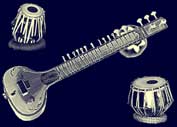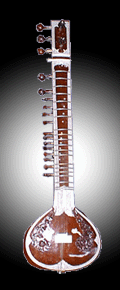
The raag is the most important concept within Indian Music. The Hindi/Urdu word raag is derived from the Sanskrit word raga which means 'colour' or 'passion', and may therefore be thought of as an acoustic method of colouring the listener's mind with an emotion.
Simply defined, each raag is a set of principles which leads to one type of melodic organisation of a scale. A raag is a system or melodic framework which can produce an unlimited number of melodies and, if performed correctly, the melodies and phrases set to one raag will all have a striking resemblance to each other in the general melodic effects it produces. Each raag over time has attained a sharp personality and has a mood, atmosphere and character, which is determined by the constant use of certain notes. The result is a melodic structure which is easily recognisable, yet infinitely variable.
No two performances of the same raag, even two performances by the same musician, will be identical. The objective of any artist is to capture that essential personality and flavour.
The Thaat
The thaat is the modal structure that the each raag belongs to. There are 10 thaats in North Indian Music which are: Bilawal, Kalyan, Khammaj, Kafi, Bhairav, Purbi, Bhairavi, Asavari, Marwa and Todi.
In Carnatic Music the modal structure is called mela.

Indian classical music notation is similar to the tonic sol-fa notation, for example the tonic of any major scale is Doh, followed by Ray, Me, Fah, Soh and so forth.
| Tonic Sol-fa: | Doh | Ray | Me | Fah | Soh | La | Te | Doh |
| Indian notation: | Sa | Re | Ga | Ma | Pa | Dha | Ni | Sa |
Vadi and Samvadi
When establishing a raag, 2 notes of the scale become very significant and serve as fulcrums for organising the phrases. These are called the vadi and samvadi, the samvadi being subordinate to the vadi. They are usually at fourth or fifth intervals to each other.
Komal and Tivra
The komal swar (flattened notes) are designated with a horizontal bar beneath them. The tivra swar (sharpened notes) are designated with a vertical line over them. The only note that may be sharpened is the Ma.
These are part of the basics of Bhatkhande's notational system which is widely accepted in India although there are a few other systems which may also be found.
Aarohi and Avrohi
The aarohi are the ascending notes of the raag scale and the avrohi are the descending notes.

There are three main components to Indian Classical Music, the drone, which is tuned to the tonic and the main notes of the raag and sounds throughout a performance, the raag as outlined above, and the tal, which is the rhythmic cycle.
Each tal is characterised by a particular rhythmic pattern or cycle, and they are represented by a series of strokes on the drum. Each stroke has a syllable attached to it and is known as bol. Indian music is known to contain unlimited scope for rhythmic complexity and each specific tal has a specific name and number of beats in a strictly defined sequence.
A tabla player may vary the strokes that he plays and also improvise, however this is done in a manner consistent with the rhythmic cycle. He will also differentiate between the tali (on-beat) and khali (off-beat), which are defined for each tal. The most important beat of the tal is the first one call sam. In performance, the soloist may improvise for many cycles of the tal, but will generally always return to the composition on the sam.